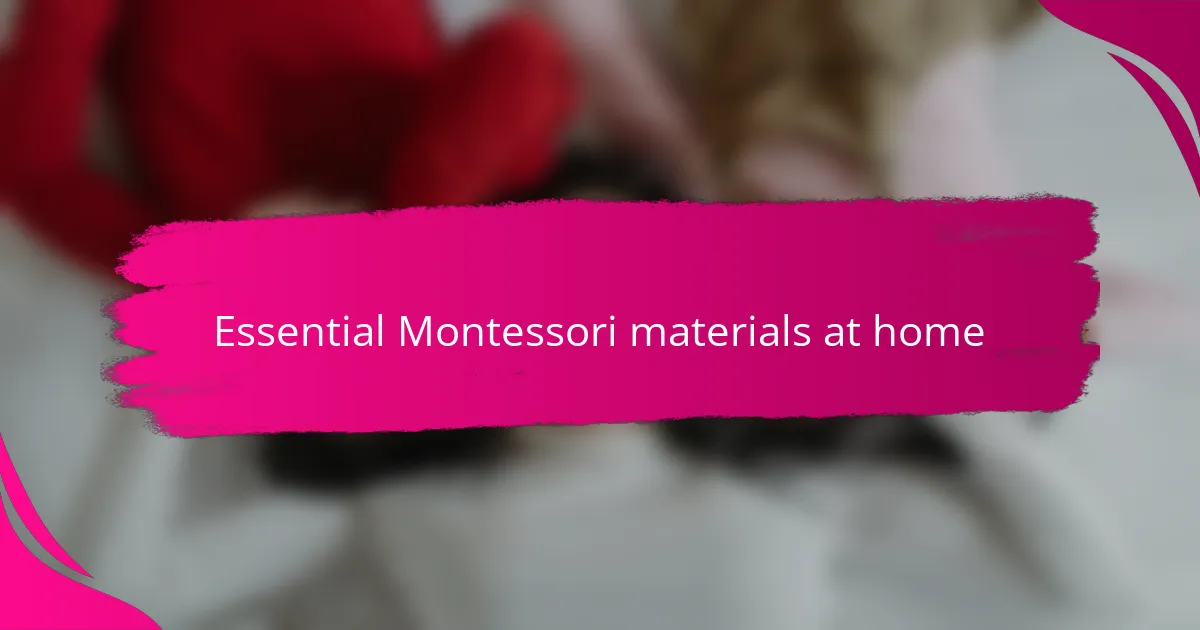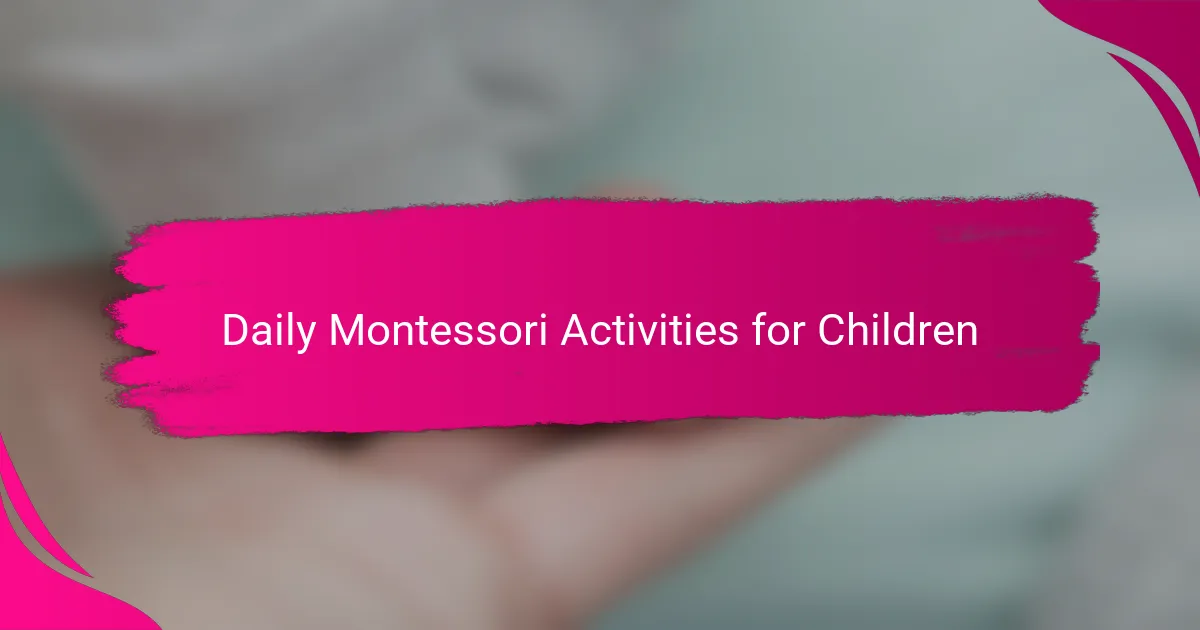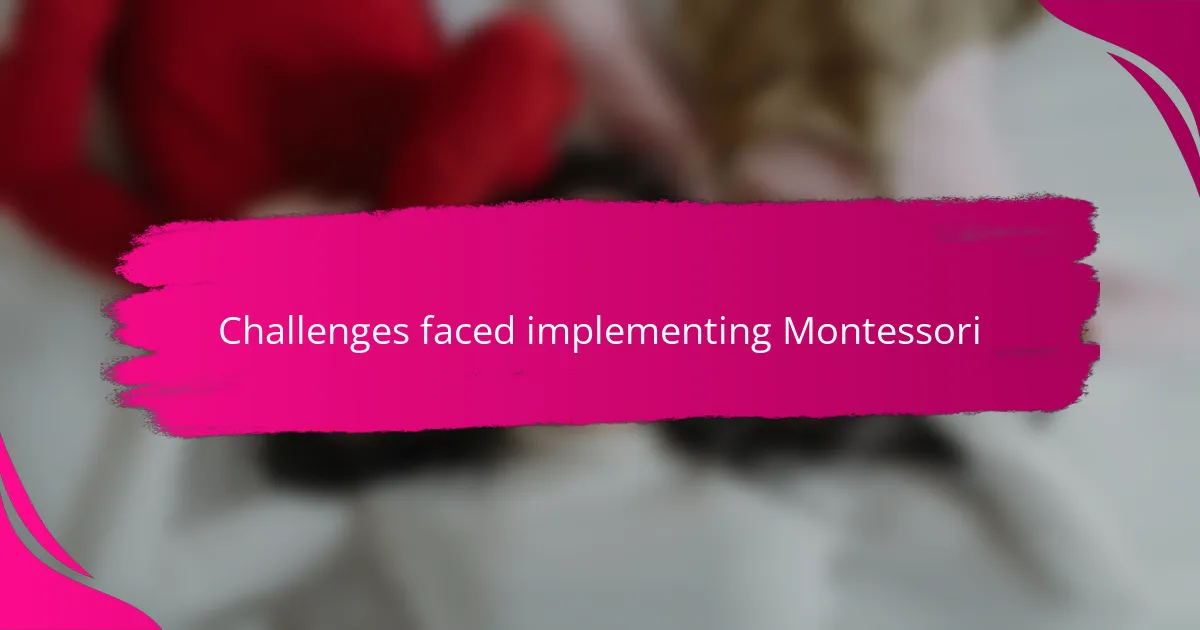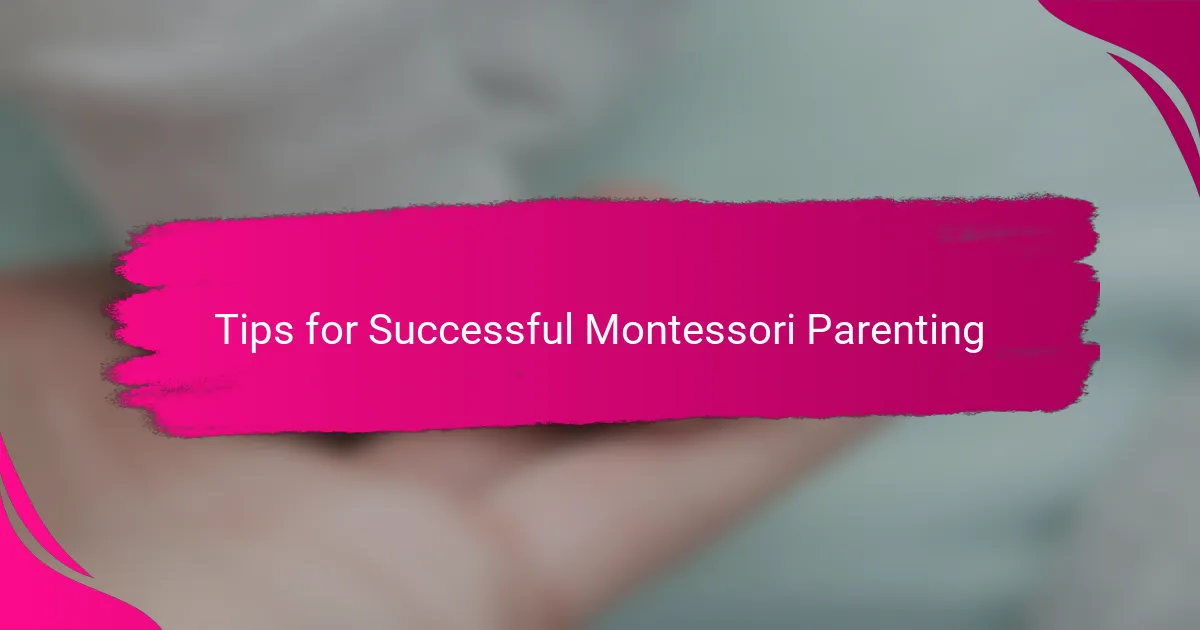Key takeaways
- Montessori methods empower children by promoting independence and encouraging exploration through hands-on activities.
- Creating a well-organized and accessible learning environment fosters curiosity, focus, and confidence in children.
- Incorporating practical life skills into daily routines enhances children’s responsibility and engagement with their surroundings.
- Patience and a balance between guidance and freedom are crucial in supporting a child’s natural learning process within the Montessori framework.

Understanding Montessori methods basics
When I first came across Montessori methods, what struck me was the idea of treating children as capable individuals rather than passive recipients of knowledge. It made me rethink how I approached learning moments at home—shouldn’t my child explore and discover at their own pace? This shift in perspective created a more respectful and curious atmosphere in our daily routine.
Montessori emphasizes hands-on activities and real-world materials, which I found incredibly grounding. Instead of relying on screens or flashy toys, I started providing objects that my child could physically manipulate and learn from. Watching their focused expression as they worked on a simple task like pouring water convinced me that engagement and independence go hand in hand.
One of the most powerful lessons I learned is that the environment plays a huge role in learning. By organizing our space to be inviting and accessible, I noticed how my child naturally gravitated toward activities that fostered concentration and coordination. Isn’t it amazing how much a thoughtfully prepared space can nurture confidence and self-discipline?

Preparing your home for Montessori learning
Setting up our home for Montessori learning wasn’t about buying special equipment but about creating a space that respects my child’s independence. I rearranged shelves to make materials reachable, and suddenly, my little one was choosing activities all by themselves—no prompting needed. Have you ever noticed how a simple change in environment can spark curiosity without a single word from you?
I also learned the value of simplicity. Removing clutter and limiting toys to just a few meaningful items made our space calmer and more inviting. It felt like the whole room was encouraging focus, not distraction, which honestly made both of us more relaxed during learning time.
One thing that surprised me was how much my child appreciated having areas dedicated to different tasks—a cozy reading nook, a low table for pouring or sorting, and a little shelf just for art supplies. Watching them move confidently between these zones reinforced how important it is to prepare a home that supports their natural rhythms and interests. Isn’t that the ultimate goal, after all?

Essential Montessori materials at home
Choosing the right materials was a game-changer for me. I started with simple items like wooden blocks, a small pitcher for pouring exercises, and baskets to sort natural objects. These materials weren’t flashy, but they invited my child to explore with their hands, which felt so rewarding to witness.
I remember how excited my child was when I introduced a set of knobbed cylinders. At first, it seemed like just a puzzle, but soon I noticed how their focus deepened, and they became more aware of size and shape differences. Isn’t it beautiful when a simple object can spark such concentration and learning?
What surprised me most was how these materials encouraged independence without constant instructions. My child learned to handle them gently and put everything back in place, creating a small sense of order and responsibility. Isn’t that what we all hope for—a child who’s both curious and respectful?

Daily Montessori activities for children
Each day, I make sure to include activities that encourage my child’s independence, like pouring water from a small pitcher or transferring beans with a spoon. These simple tasks might seem mundane, but I’ve seen how they build concentration and fine motor skills in ways that feel natural and satisfying. Have you ever noticed how proud children look when they master something on their own?
Incorporating practical life skills like folding cloth napkins or sweeping the floor turned out to be a highlight of our routine. I found it deeply rewarding to watch my child take on these responsibilities enthusiastically, and honestly, it brought a new sense of partnership into our home. Isn’t it amazing how everyday chores can become meaningful learning moments?
Sometimes, I set up nature-inspired activities, like sorting leaves or arranging flowers, which spark curiosity and creativity. These moments remind me that Montessori isn’t just about skill-building but also about connecting with the world around us. Have you tried using natural materials? It truly adds a special dimension to learning at home.

Challenges faced implementing Montessori
One of the biggest challenges I faced was balancing structure with freedom. Montessori encourages child-led activities, but I often found myself wondering, “Am I stepping in too much or too little?” It took time and patience to trust my child’s pace without feeling the urge to constantly guide or correct.
Another hurdle was managing my own expectations. I wanted quick results, but Montessori learning is subtle and unfolds slowly. I remember feeling frustrated when progress seemed invisible, only to realize later that these small, quiet moments of focus were actually huge developmental leaps.
Creating an organized environment also demanded continuous effort. Toys and materials needed constant tidying and rotation to keep the space inviting. Sometimes, I felt overwhelmed by the upkeep, but then I reminded myself: isn’t setting up this order part of nurturing independence and respect for the environment?

Personal benefits experienced with Montessori
I found that one of the most rewarding personal benefits of using Montessori methods at home was witnessing my child’s growing confidence. When given the freedom to choose and complete tasks independently, their sense of accomplishment was palpable. Have you ever noticed how a child’s pride shines differently when they’ve mastered something without constant help? It’s truly uplifting.
Another benefit I experienced was a noticeable increase in my child’s patience and concentration. Montessori activities demand focus, which isn’t always easy for little ones, but I saw their attention span lengthen naturally over time. It made me realize how effective thoughtfully designed learning can be—no screens or distractions, just pure engagement.
Finally, embracing Montessori at home deepened the bond between me and my child. By stepping back to observe rather than direct, I gained a new appreciation for their unique way of thinking and problem-solving. Doesn’t it feel rewarding when you can watch your child thrive on their own terms? For me, that connection became one of the greatest gifts of this journey.

Tips for successful Montessori parenting
Finding the balance between guiding and stepping back was key in my Montessori parenting journey. I learned that offering gentle encouragement instead of direct instruction allowed my child to develop confidence and problem-solving skills. Have you ever noticed how children surprise you when given the space to figure things out on their own?
Keeping patience was another crucial tip. Early on, I struggled with expecting quick results, but Montessori taught me that growth often happens quietly and gradually. When I reminded myself to celebrate small moments of focus and independence, I felt more connected to my child’s unique learning rhythm.
Lastly, consistency in maintaining an organized, inviting environment made a big difference. It wasn’t always easy to keep materials accessible and tidy, but witnessing my child independently select and return activities made the effort worthwhile. Isn’t it incredible how a well-prepared space can nurture both responsibility and curiosity?
